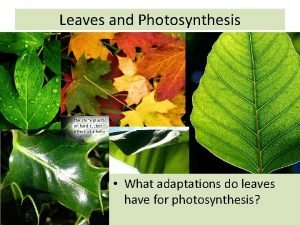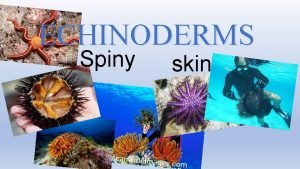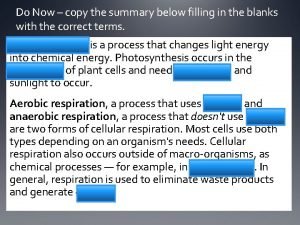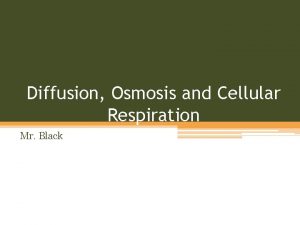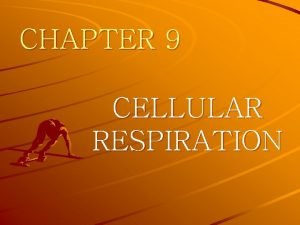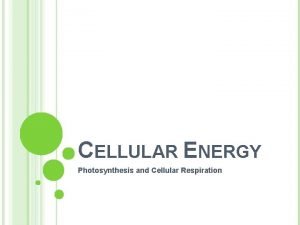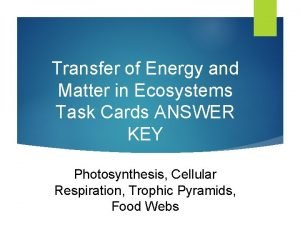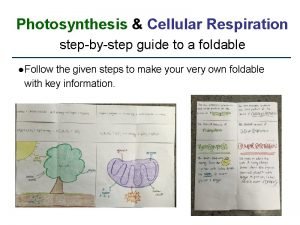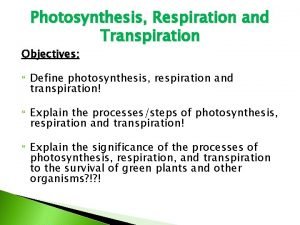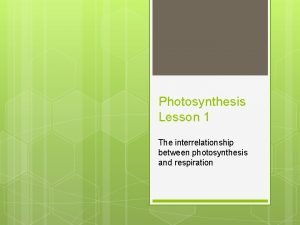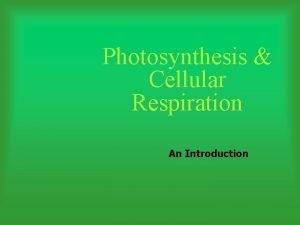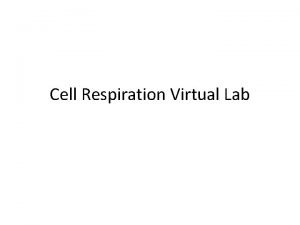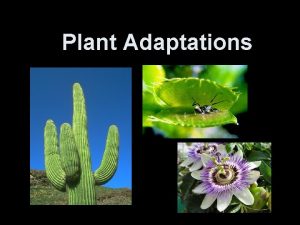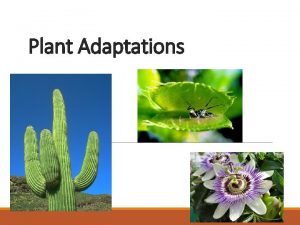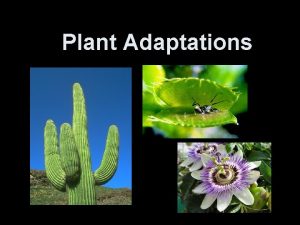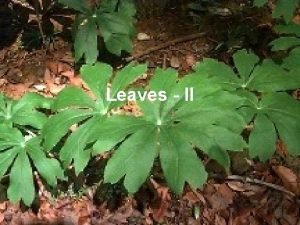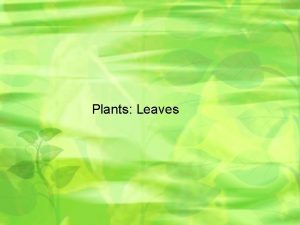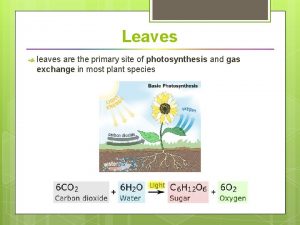Leaves and Photosynthesis What adaptations do leaves have






















- Slides: 22

Leaves and Photosynthesis • What adaptations do leaves have for photosynthesis?

Plant cell wall cell membrane cytoplasm nucleus vacuole chloroplast

Name the structure… Function Structure Controls what goes in and out of the cell membrane Contains the genetic material. nucleus Surrounds the cell and gives support. cell wall Contains chlorophyll and absorbs sunlight. chloroplasts Contains cell sap and gives support. vacuole Where all the chemical reactions happen. cytoplasm

Chloroplasts absorb sunlight

Green plants have chlorophyll Lets investigate the pigments in chlorophyll. In groups of 3: • Person 1 Collects a leaf and cuts it up and uses pestle and mortar with 10 ml of acetone to grind up leaf • Person 2 Measures out a 1 cm of acetone in a 250 ml beaker and on a piece of chromatography paper draws a line in pencil 2 cm up from the bottom • Person 3 Sets up filter funnel to collect filtrate, use a capillary tube to paint a green dot on the pencil line and hang the paper in the acetone.

Chromatography set up

External: How leaves are adapted for efficient photosynthesis Side vein Apex Mid-rib vein Leaf stalk (petiole) Leaf blade (lamina)

Draw this table in your books Feature of leaves Broad, flat leaves Stomata Veins Chloroplasts Waxy layer Thin How it aids photosynthesis

How leaves are suited to photosynthesis • Leaves are broad and flat, giving large surface area to absorb as much light as possible.

They have ‘holes’ in the leaves to allow carbon dioxide in and oxygen out. These are STOMATA. Stoma Guard cells

There are veins in the leaves to transport water and sugar around.

Many of the cells are packed with chloroplasts which contain a light trapping pigment- chlorophyll.

There is a waxy layer on top to stop water being lost from the leaf.

Thin leaves provide a short diffusion distance for carbon dioxide to reach the palisade and mesophyll cells

HT: How structure of the leaf is adapted for efficient photosynthesis • Epidermis is transparent; • Palisade layer at the top containing most of the chloroplasts; • Air spaces in the spongy mesophyll allow diffusion between stomata and photosynthesising cells; • Internal surface area / volume ratio very large.

Leaf cross section • In pairs examine a slide of

Use microscopes to observe internal structure of leaves

Check out your chromatogram • How many pigments are there? • What colours are they? • Do you think red seaweed would produce the same chromatogram?

HT: Absorption spectrum • The peaks show the amount of light absorbed by different pigments. • Having several chloroplast pigments means plants can absorb light across a greater range of colour wavelengths.

FT: Plenary • Use what you now know about leaves and photosynthesis to design an ‘ideal leaf’ that will maximise photosynthesis • Draw and label your leaf to explain how it is adapted to be more efficient (You may want to include the external environment it would be found in e. g. A desert or rainforest)

HT: Plenary Questions • Draw this diagram of a Marram grass leaf.

Marram grass is found on sand dunes. 1) What does the waxy cuticle do? 2) How does the position of the stomata help this plant? 3) Why are there no stomata on the outer surface of the leaf? 4) Explain the function of the hairs on the inner surface of the leaves? 5) Explain how having sunken stomata will affect gaseous exchange in the plant, and why this would be an advantage to the plant.
 What are the adaptations of leaf for photosynthesis ?
What are the adaptations of leaf for photosynthesis ? What shape has 8 faces
What shape has 8 faces Which part of the plant carries and protects the seed
Which part of the plant carries and protects the seed Plants called sundews have rounded green leaves
Plants called sundews have rounded green leaves Words have meaning and names have power
Words have meaning and names have power The zoo dangerous curves
The zoo dangerous curves Endoskeleton, often has spiny skin
Endoskeleton, often has spiny skin Complementary processes
Complementary processes Formula photosynthesis and cellular respiration
Formula photosynthesis and cellular respiration Axolotl food
Axolotl food What is the equation for cellular respiration
What is the equation for cellular respiration Venn diagram photosynthesis and respiration
Venn diagram photosynthesis and respiration Venn diagram photosynthesis and respiration
Venn diagram photosynthesis and respiration Function of cellular respiration
Function of cellular respiration Function of cellular respiration
Function of cellular respiration Photosynthesis and cellular respiration diagram
Photosynthesis and cellular respiration diagram Cellular respiration foldable
Cellular respiration foldable Chemosynthesis vs photosynthesis venn diagram
Chemosynthesis vs photosynthesis venn diagram Edpuzzle cellular respiration
Edpuzzle cellular respiration Photosynthesis define
Photosynthesis define Interrelationship between photosynthesis and respiration
Interrelationship between photosynthesis and respiration Photosynthesis and cellular respiration
Photosynthesis and cellular respiration Cell respiration virtual lab
Cell respiration virtual lab
